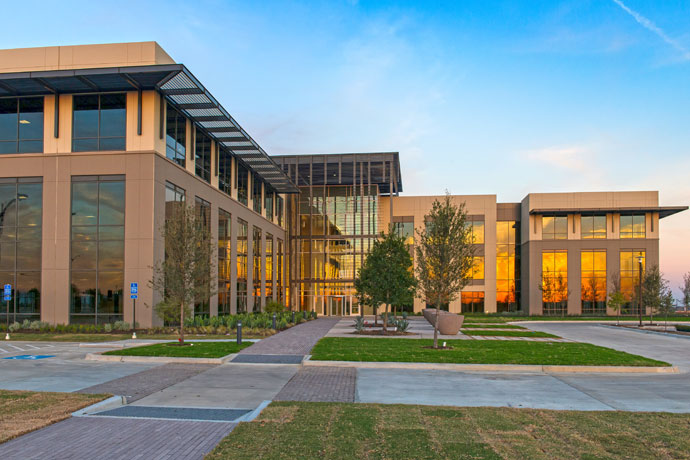Shopping for the best logistics location? It might pay to follow the same logic you use when shopping for anything else: Start with Amazon.
Since January 2012, Site Selection has tracked more than 50 facility investments from Amazon. Some are at its growing micro-city in Seattle. Some are affiliated with its contact center and Web services divisions. But most — such as a $75-million, 1,000-job facility at a yet-to-be-chosen location in Illinois announced in October — are simply tentacles in its global distribution empire. Amazon recently announced it would hire 80,000 seasonal employees to fulfill customer orders during the 2014 holiday period, a 14-percent increase over last year. The company expects that thousands of those employees will stay on in regular, full-time roles.
Hillwood Properties knows Amazon. The property developer and proprietor of the AllianceTexas and AllianceCalifornia logistics mega-parks has done five deals with the e-commerce giant, in addition to projects with Walmart.com. Like most who do business with Amazon.com, they can’t talk about it. But Bill Burton, Hillwood’s senior vice president, can talk about the model Hillwood’s pursuing as it’s stretched its own concerns into other locations domestically and abroad. He joined Hillwood in 1989 when AllianceTexas was just getting started, and has been one of the principal drivers behind that 18,000-acre, master-planned development that is home to more than 370 major companies with more than 40,000 employees.
“We love ports, and we love high-growth corridors,” he says. And if the infrastructure isn’t there, they look to make it appear. “We started in Alliance before there was an airport or intermodal — we built those,” he says. “We continue to improve the machine, if you will,” including the addition of heavy-load rail. “We put in place the key infrastructure to attract the users we have today.” Those include two new hubs going in almost simultaneously from Fedex Ground and UPS Ground, whose hub is going into former LG Electronics space after LG decided to consolidate its white goods and electronics inventories in one building instead of two adjacent buildings. As one might expect of top logistics performers, UPS was moving in as LG was still operating in the building and moving out, says Burton, in order to be up and ready for the holiday season.
Having UPS and Fedex at Alliance, of course, is good for all concerned, as their dual presence means late cutoff times and competitive prices and service offerings. One telecom equipment logistics firm has employees from both UPS and Fedex in its warehouse, says Burton. “When the product comes off the conveyor, it’s put into pre-weighted, pre-sorted air containers and put directly on the plane. That saves a significant amount of time. Because of the competition between UPS and FedEx here, they have a very competitive per-piece price they end up paying, and they ship out 300,000 packages a month.”
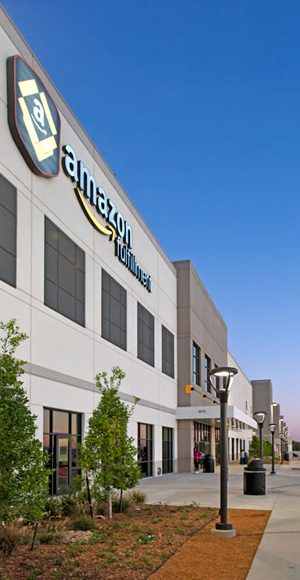
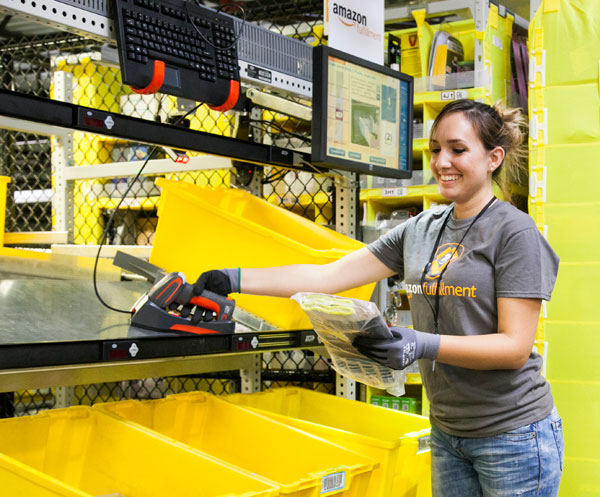
An Amazon employee picks items and a Kiva robot moves them in the company’s newest, eighth-generation fulfillment center, 10 of which are now operating in the US. The location pictured to the left is in AllianceTexas in Fort Worth.
Photos courtesy of Business Wire and Hillwood
He says there’s also an opportunity because of the tremendous number of empty containers.
“We consume a lot of product here in DFW, and the distribution network generally served out of North Texas is five to eight states,” says Burton’s colleague, Hillwood Vice President Steve Boecking. “Then we export a fair amount of stuff, but there still is an imbalance with the empties, and there lies an opportunity to really attract some exporters, or anybody shipping product back to the West Coast or to Asia.”
The redevelopment of Norton Air Force Base in California, closed in 1994, became AllianceCalifornia, where Amazon occupies 1.5 million sq. ft. of space in two adjacent buildings right on the San Bernardino International Airport runway. In total, AllianceCalifornia is now home to 11.2 million sq. ft. of new industrial space. Burton says the Hillwood footprint is expanding to places such as Greater Memphis (Mississippi); Jacksonville, Fla.; eastern Pennsylvania; Chicago and Atlanta based on fundamentals of logistics and distribution strategy, which usually begins with population trends.
Qualified and Certified
Transportation costs and infrastructure still rule the roost as location criteria, says Burton, but the ability to recruit, train and keep labor is rising fast in importance. So AllianceTexas, in addition to operating its own fee-free clearinghouse for job openings at the development, has been the impetus behind Certified Logistics Associate and Certified Logistics Technician certifications, issued by the same organization that issues similar manufacturing technician certificates, the Manufacturing Skill Standards Council (MSSC).
“We receive requests from prospects, and one of the top one to three items on the list is workforce,” says Boecking. “It’s important not to be general. You need to be able to quantify programs in place, who the education and training partners are, how it gets paid for, and the ability to get Department of Labor grants.”
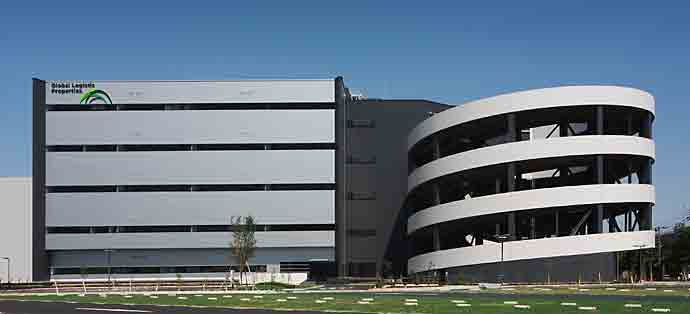
GLP Misato III, a 1-million-sq.-ft. (95,000-sq.-m.) multi-tenant logistics facility in Greater Tokyo, was the first logistics facility in Japan to receive LEED-Platinum certification. Singapore-based GLP (Global Logistic Properties) in December partnered with a sovereign wealth fund in Singapore to pay $8.1 billion for a 117-million-sq.-ft. (11-million-sq.-m.) portfolio of properties in 36 US submarkets from Blackstone Group.
Quantifying certifications and performance, he says, has helped turnover of new workers go from between 40 and 50 percent to the 5-percent range.
“That’s huge,” he says. “We have one customer who tracked the cost of a new employee over five years. A non-certificate-holder cost them $65,000 over five years, tracking turnover, retraining and mistakes. The same employee with a certificate is going to cost them $1,500. It’s hard to believe, but by the time these people show up on the job, they already know what they’re getting into. Nationally, one of the big problems with the organization that certifies the workers is awareness that it actually exists. But it’s spreading.”
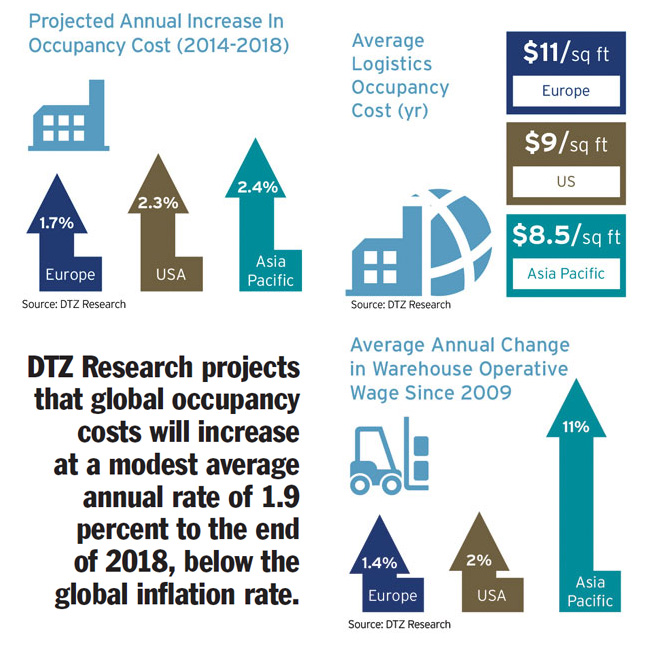
A longtime partner to several federal agencies, MSSC is also a founding partner in the National Association of Manufacturers — endorsed Skills Certification System and a charter member of the National Supply Chain and Logistics Network. To date, MSSC has given over 68,279 assessments and issued over 53,443 credentials. Its vision is to assess 20 percent of the nation’s front-line manufacturing production and material handling workers in 20 years — 3 million workers by 2030. “We have had interest from many international locations,” says Rebekah Hutton, MSSC’s vice president of strategic initiatives, including Mexico, Canada, China, India, Singapore, Pakistan and Afghanistan. But the program has yet to officially expand to any of those countries.
Domestically, Indiana leads all states through Sept. 2014 in both CPT and CLT certificates issued, with 10,069. The top five states by number of CLTs alone are:
- Texas (2,909)
- California (1,776)
- Ohio (1,044)
- Indiana (899)
- Washington (462)
Also showing strong starts in CLT numbers are Michigan, both Carolinas and Missouri.
Going Global
Hillwood’s strategy now is extending beyond US borders, as Hillwood takes positions in Calgary, Alberta, and establishes a presence in Central and Eastern Europe, beginning with Poland and Germany. In October, the firm announced that Hillwood Europe, will make direct and indirect investments in logistics real estate across major markets in Central and Western Europe through acquisitions, developments and joint ventures with other developers. The partnership is expected to deploy more than €1 billion over the next three to four years. Hillwood has already purchased existing buildings and development sites in Poland.
Hillwood Investment Properties Executive Vice President John Thomas, interviewed as he boarded a plane in Warsaw, Poland, alongside his former Trammell Crow colleague and current Hillwood Investment Properties President Tal Hicks, says the emerging markets of Poland and the Czech Republic are where Hillwood’s interest is, with the initial focus on Poland. As it happens, Amazon.com is opening five facilities in those same two countries: One near Poznan (less than a day’s drive to Europe’s second-busiest port in Hamburg) and two near Wroclaw will be built by Panattoni. Its Czech facilities will rise near Brno and Prague.
“Poland has a great legal system, and is a very ethical country, with a different but understandable process,” says Thomas, “so it’s not hard to underwrite the business. “Poland is by far the number one market in central and eastern Europe, because of transparency and the legal system, and because it happens to border Germany, which is the engine of commerce in Europe.”
It’s as easy as looking at a map, he says. Then overlay that map with knowledge of work rules in places such as France and Germany. Those rules can boost labor costs to 3.5 times what they are in Poland. Next, look at the roads themselves: In Poland there are three major highways, says Thomas, “and they’re all brand new.” Finally comes the real estate itself. Thomas says assemblages can be done, but the real help comes from special economic zones (both national and local). The Czech Republic is much the same, he says, though a building permit that takes just three months in Poland may take six to 12 months. “Go to Hungary or Romania, and you have a really big dropoff in transparency, and in activity because of it,” he says.
As for Germany, Thomas first compliments its “unbelievable road system,” which because of its ubiquity means plenty of exits and plenty of corners on which to build. The process often involves a municipality purchasing and converting land to industrial zoning, then selling it to users. The cities don’t like selling to spec projects, he says, because they want jobs. By the same token, they are not out to maximize land sales profit:
“I’ve been working the market for 10 years, and land we looked at before is the same price today,” says Thomas. “If they buy the land from the farmer at $2 a foot, then turn it around and zone it and have $3 a foot in the land, they want to sell it for $3 a foot They are not trying to make a profit on it — they just want the jobs. They’ll sit on it. Unlike Central and Eastern Europe, which are basically a bunch of entrepreneurs, in Western Europe you have the cities controlling it.”
Thomas says because it’s so easy now to cross country borders in Europe, there is a regionalization opportunity when it comes to logistics. “If you have a DC in Frankfurt, you could drive to France, Poland, Denmark, Netherlands and Belgium without stopping. That is going to change the long-term distribution patterns here, and will change the sites that will be selected. It’s in the second inning of a nine-inning game. It’s still early.”
Occupier Intelligence
DTZ Research’s 2014 Global Occupancy Costs – Logistics report published in October 2014 presents the current costs of occupying prime logistics space across 89 markets worldwide. The report says occupier demand will grow steadily across all three regions, but because of uneven recovery rates, a responsive supply pipeline and innovative facilities and operations, DTZ projects that global occupancy costs will increase at a modest average annual rate of 1.9 percent to the end of 2018, below the global inflation rate.
That’s good news for corporate occupiers, though differences exist within and between regions.
“Occupiers in Europe will benefit from the lowest occupancy cost increases to 2018 [1.7 percent pa, or per annum],” said Richard Yorke, global head of occupier research for DTZ. “Milan and Dublin are exceptions as they are recovering from recent steep declines. Meanwhile, landlords in the US are starting to get the upper hand as demand for warehouse space grows. This will translate into cost increases [that] will surpass the US inflation level. Atlanta and Houston are forecast to be amongst the five centers due to see the fastest growth in costs globally. Asia Pacific will see the highest regional cost increase, in percentage as well as absolute terms. By 2018, the cost for one square meter of prime logistics space in Hong Kong and Singapore will have grown by nearly US$40 and US$50, respectively.”
Doing the Leg (and Back) Work
The DTZ report analyzed labor costs too, finding that logistics operators in China and India have access to the most affordable warehouse labor. The average warehouse operative salary in the US is nearly five times higher than in China. However, Asia Pacific has seen the highest increase in labor costs since 2009, reflected by an average annual growth rate of 11 percent, compared to 1.9 percent in the US and 1.4 percent in Europe.
Milena Kuljanin, author of the report, highlighted China in particular, where the Economist Intelligence Unit recently forecast manufacturing labor annual personal earnings growth of 12 percent between 2013 and 2020. But Kuljanin said China would remain cost-competitive even against established emerging markets. In logistics, that advantage might not hold.
“In Shenzhen for instance, warehouse operative wages have increased by more than 15 percent per annum since 2009,” said Kuljanin. “This reflects an imbalance between the demand and supply of labor and also indicates a shift in the economics of global logistics. Future increases in wages and occupancy costs will further reduce China’s cost advantage. Whilst some companies have reshored operations to US and Europe, others are seeking out more affordable inland provinces and neighboring countries such as Vietnam and Indonesia.”
DTZ said six of the top 10 most expensive markets globally are European, with London at the top. However, there are low cost locations in Europe including Milan, Brussels and Marseille, which offer occupiers relatively affordable prime logistics space. Similarly, there are large intra-regional differences in Asia Pacific where high costs in Singapore and Hong Kong are contrasted by much lower costs in India and Chinese tier II markets. Cost differences in the US are less apparent than in the other regions. But there is a clear division, DTZ said, between the most affordable Southern US markets such as Memphis, Atlanta and New Orleans and the West Coast markets San Francisco, Los Angeles and Seattle.
“Increased occupier demand in the US, and with it rising costs which are expected to exceed general inflation, will require logistics facilities to deliver greater efficiencies,” said Greg Schementi, head of US tenant representation at DTZ. “This is driving the supply of larger; more technologically advanced warehousing in close proximity to urban areas.”
UPS in December announced it was adding 1.2 million sq. ft. to its global supply chain network of 32.8 million sq. ft. and 596 facilities by adding 1.2 million sq. ft. at four of those urban locations: Mira Loma, Calif. (five minutes from the LA/Ontario Airport and an hour from the Ports of L.A. and Long Beach); Hebron, Ky. in Greater Cincinnati; Shepherdsville, Ky. (20 minutes from the UPS Worldport in Louisville); and Mississauga, Ont., 10 minutes from Toronto’s Pearson International Airport.
New Player in the US Not So New Abroad
Singapore-based Global Logistic Properties Ltd. seems to be onto that trend. The firm, known for its investments in advanced facilities in Japan, manages 290 million sq. ft. (27 million sq. m.) of logistics properties in China, Japan, Brazil and, now, the US. In November it expanded its JV with Canada Pension Plan Investment Board (CPPIB) to develop more logistics properties there, bringing the total venture size to $2.2 billion. Together with another investor, GLP and CPPIB also are pursuing $1.1-billion partnership in Brazil in 9.6 million sq. ft. of space, separate from $1.4 billion worth of other Brazilian JVs it’s formed to invest in 40 other Brazilian properties.
Represented by Morrison & Foerster, an affiliate of GLP also invested in the formation of the world’s largest China-focused logistics infrastructure fund. But its most recent foray is its biggest yet: On Dec. 8, again advised by Morrison & Foerster in a co-investment with Singapore sovereign wealth fund GIC Pte. Ltd., GLP committed to buy one for $8.1 billion one of the largest logistics real estate portfolios in the United States from the Blackstone Group. Called “GLP US Income Partners I,” it marks the firm’s first entry into the US market, and comprises 117 million sq. ft. (11 million sq. m.) of total gross floor area spread across 36 major sub-markets in the US. In one fell swoop, the firm jumps to third behind Prologis and Duke Realty in total US logistics square footage.
Almost a third of that area is in the West, which the company noted “has greater port and distribution traffic,” with the balance more or less evenly split among the other US regions. Leading tenants by leased area include Whirlpool, Home Depot, Ozburn-Hessey Logistics, Amazon.com, FedEx and Iron Mountain.
GLP said it is acquiring the US$8.1-billion portfolio at a significant discount to replacement cost. “The portfolio is 90-percent leased as of 30 September 2014, with a weighted average lease expiry of 3.2 years,” said the company. “In-place rents are estimated to be approximately 7 percent below market. GLP is focused on increasing the lease ratio in the near-term. Increasing rents and occupancy provide potential for upside.
“Lack of construction over the past five years has led to limited new supply of 0.4 percent of total stock per year,” said the firm. “There is stable demand for logistics infrastructure driven by continued growth in retail and e-commerce sales, which are growing faster than GDP.”
